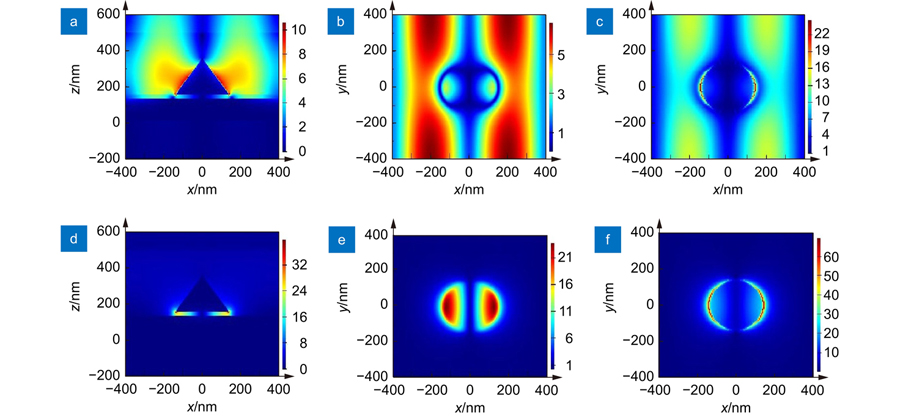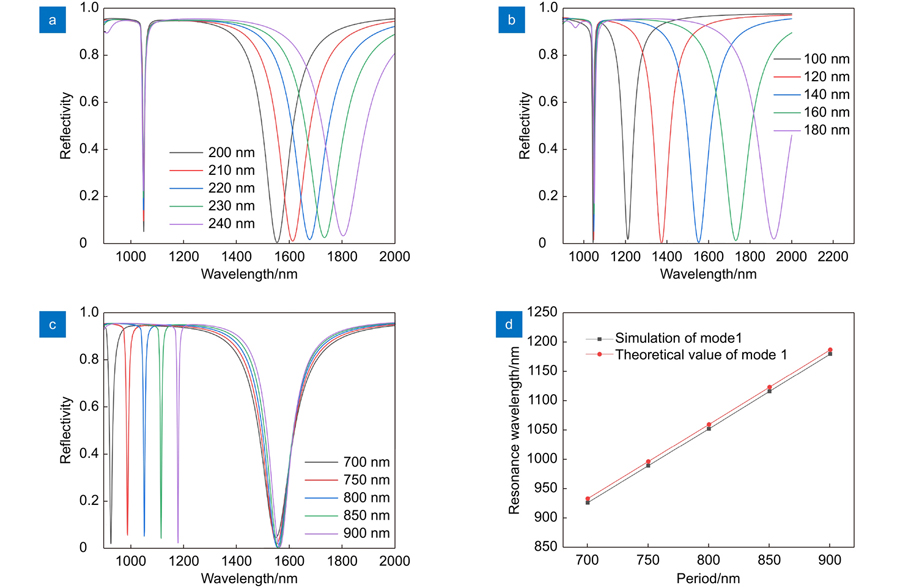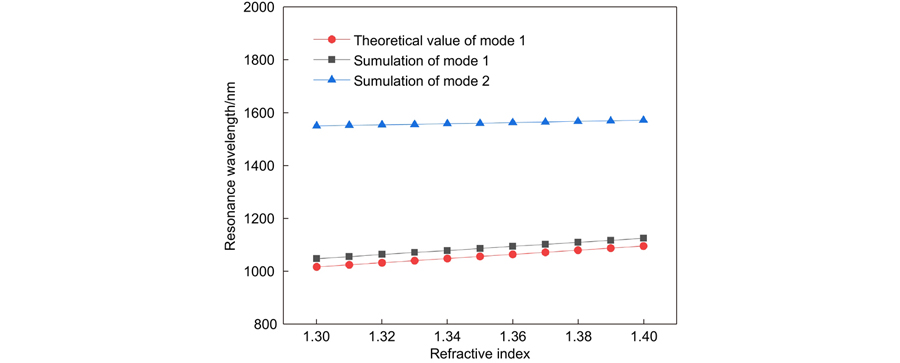金纳米锥阵列与金薄膜耦合结构表面等离子体折射率传感研究
1 引言
在一定条件下,金属表面的自由电子经过入射光照射,入射光波中的光子与金属表面的自由电子相互作用产生的电磁振荡被称之为传播表面等离子体[1-2](propagating surface plasmons, PSPs)。而当入射光作用于金属纳米颗粒上时,所产生的电磁振荡称为局域表面等离子体[3-4](localized surface plasmons, LSPs)。在金属纳米颗粒和金属薄膜复合结构中,由于传播表面等离子体和局域表面等离子体的高效激发,使得微纳结构热点处的电磁场得到很大提高。这一特性也使得它在光催化[5-7]、纳米光刻[8-9]、生物传感[10-13]、超表面[14]、吸收器[15-17]以及表面增强拉曼散射[18-19]等领域得以广泛应用。
近几年,研究人员制备了不同形状、尺寸的纳米颗粒以及纳米颗粒与金属薄膜复合结构,使得这些微纳结构在应用方面的研究得到了广泛的关注。Qiang Fu[20]等人通过银纳米立方体和银金属光栅的复合结构,实现了传播表面等离子体与局域表面等离子体的相互耦合。Chu[21]等人研究了二维周期性金纳米盘阵列、二氧化硅间隔层和金薄膜组成的复合结构,通过改变金纳米盘的尺寸和阵列周期,发现共振条件下复合结构中单个金纳米盘的电场增强高达5000,远高于玻璃基片上单个金纳米盘的电场增强。此外,Kohandani[22]等人通过在周期性二维纳米光栅(金纳米颗粒阵列)下方引入薄金层,实现了429 nm/RIU的灵敏度。Abutoama[23]等人通过在薄金属膜上添加薄介质(Si3N4)光栅,在金属膜的两个边界处产生了两种表面等离子体,其中一种等离子体对分析物折射率敏感,其灵敏度达到580 nm/RIU。迄今,各种基于亚波长金属颗粒的表面等离子体折射率传感器已在实验或理论研究上均获得成功,如纳米球[24-26]、纳米线[27-31]及相互作用的颗粒集团等。随着微纳光刻技术的不断发展,通过颗粒阵列及薄膜结构耦合的方式来激发表面等离子体从而进一步提升折射率传感器的灵敏度、集成度及便携性仍然具有重要意义并表现出可观的应用潜力。
本文设计了金纳米锥与金薄膜耦合结构,并具体探究其所激发的表面等离子体效应,利用时域有限差分法对结构进行数值模拟研究,探究了结构的几何参数对折射率传感的影响。在光栅周期为800 nm,金纳米锥底面半径为140 nm,高度为200 nm时,耦合结构的折射率灵敏度可达770 nm/RIU。在900 nm~2000 nm的波长范围内,结构可以实现折射率范围1.30~1.40的传感,且可以通过改变结构周期或金纳米锥的几何参数来调谐共振波长。相比类似的折射率传感器件,所设计的结构在生物传感和检测方面具有较大的应用潜力。
2 理论分析

图 1. (a) 金纳米锥与金纳米薄膜复合结构三维示意图;(b) 结构俯视图,红色方框为计算单元
Fig. 1. (a) Three dimensional schematic diagram of the composite structure of Au nano cone and Au nano film; (b) A top-down view of the structure, and the red foursquare lattice is the calculation unit
该结构具有同时激发传播和局域表面等离子体共振的条件,入射电磁波能量通过单个金纳米锥可以激发局域表面等离子体共振,而金纳米锥组成的二维点阵可以激发传播表面等离子体共振。金纳米锥阵列作为一个二维点阵光栅提供额外的动量,从而将入射波能量耦合到传播表面等离激元中。补偿的额外动量[21, 32]:
其中:n和m是衍射阶数,为整数,D为光栅常数(即阵列周期)。(n, m) = (1, 0)和(1, 1)代表低阶共振波长下的两种模式,而随着(n,m)的增大,共振频率会越来越高。
其次,当TM极化波垂直入射时,二维光栅激发的表面等离子体共振波长可表示为[33-34]
其中:n和m为衍射阶数,P为二维光栅的周期,nanalyte为分析物折射率,ɛmetal为金属的复介电常数。光栅激发的表面等离子体共振波长与光栅周期有关,随着周期的增加,共振波长将发生红移。
当复合结构产生表面等离子体共振时,表面等离子体波对周围环境介质的变化十分敏感,故而共振波长的移动对应待测物的折射率变化。通过建立起待测物折射率与共振波长的曲线对应关系,即可达到折射率传感的目的。
传感器灵敏度(sensitivity,S)和品质因数(figure of merit,FOM)是描述传感器性能表现的两个物理参量,这两个参数值越高,则代表传感器性能越好。折射率灵敏度的定义为[33]
其中:Δn为折射率(refractive index units,RIU)变化量,Δλ为Δn对应的共振波长偏离量。品质因数的定义为[34]
其中:FWHM指的是用于折射率传感的共振峰的半高全宽(full width at half maximum,FWHM)。
3 研究结果与讨论

图 2. 金纳米锥与金薄膜复合结构的反射光谱。金纳米锥底面半径为140 nm,高为200 nm,周期为800 nm,背景折射率为1.30
Fig. 2. Reflection spectra of composite structure of gold nano cone and gold film. The bottom radius, the height and the period of the gold nano cone are 140 nm, 200 nm, 800 nm, and the background refractive index is 1.30
复合结构中两种共振模式下的电场分布如

图 3. 复合结构中两种模式共振波长下的电场分布图。金纳米锥底面半径为140 nm,高度为200 nm,周期为800 nm,背景折射率为1.30. (a)和(d)为x-z平面上的电场分布, (b)和(e)为SiO2间隔层下表面和Au薄膜界面上的电场分布,(c)和(f)为分析物与SiO2间隔层上表面上的电场分布; (a)、(b)、(c)为模式1,(d)、(e)、(f)为模式2
Fig. 3. Electric field distributions of the composite structure at two modes resonance wavelengths. The bottom radius, the height and the period of gold nano cone are 140 nm, 200 nm and 800 nm. The background refractive index is 1.30. (a) and (d) are the electric field distribution on the x-z plane; (b) and (e) are the electric field distribution on the lower surface of the SiO2 spacer and the interface of the Au film; (c) and (f) are the electric field distribution on the surface above the analyte and the SiO2 spacer; (a), (b) and (c) are mode 1, (d), (e) and (f) are mode 2
下面进一步研究在不同参数下金纳米锥复合结构的反射光谱,分析结构参数对共振模式的影响。

图 4. 背景折射率1.30,不同参数下复合结构的反射光谱。(a) D为800 nm,R为140 nm,H从200 nm~240 nm;(b) D为800 nm,H为200 nm,R从100 nm~180 nm;(c) H为200 nm,R为140 nm,D从700 nm~900 nm;(d) 不同周期下模式1共振波长的仿真值与理论值
Fig. 4. The background refractive index is 1.30, the reflection spectra of the composite structure under different parameters. (a) D 800 nm, R 140 nm, and H changes from 200 nm to 240 nm; (b) D 800 nm, H 200 nm, and R changes from 100 nm to 180 nm; (c) H 200 nm, R 140 nm, and D changes from 700 nm to 900 nm; (d) Simulation and theoretical values of mode 1 resonance wavelength at various period
从金纳米锥复合结构在不同参数下的反射光谱可以看出,模式1主要受光栅周期的影响,所引起的共振主要是传播表面等离子体共振。而模式2受金纳米锥几何参数的影响更大,主要是由局域表面等离子体共振引起的。
最后,讨论模式1和模式2的传感特性,分析共振模式对结构传感器灵敏度及品质因数的影响。

图 5. 不同分析物折射率下复合结构的反射光谱。金纳米锥的半径为140 nm,高度为200 nm,周期为800 nm
Fig. 5. Reflection spectrum of the composite structure under different refractive index of analyte. The radius of Au nano cone is 140 nm, the height is 200 nm, and the period is 800 nm

图 6. 不同待测物折射率下复合结构反射光谱共振波长与折射率变化的关系曲线。金纳米锥的底面半径为140 nm,高度为200 nm,周期为800 nm
Fig. 6. Relationship curves of reflection spectrum resonance wavelength of the composite structure with refractive index change under different refractive index of object to be measured. The bottom radius of gold nano cone is 140 nm, the height is 200 nm, and the period is 800 nm
通过以上研究可知,无论是灵敏度还是品质因数,模式2都要比模式1低很多且品质因数相差较大。模式1之所以具有较高的灵敏度,是因为其主要是由传播表面等离子体共振引起的,而模式2主要是由局域表面等离子体共振引起的。即模式1相较于模式2对环境电介质折射率的改变要更敏感,因此模式1有更高的折射率灵敏度。而品质因数的大小同时取决于灵敏度和半高全宽,模式1的灵敏度不仅要比模式2大很多,而且其半高全宽也小很多。
4 结论
设计了基于SiO2间隔的金纳米锥阵列与金薄膜耦合结构表面等离子体共振折射率传感器。从反射光谱和电场分布两个角度进行了理论分析和数值模拟研究,论证了复合结构可以有效激发表面等离子体共振。在确定的几何参数下,复合结构在模式1中主要形成传播表面等离子体共振,而在模式2中主要形成局域表面等离子体共振。在金纳米锥底面半径为140 nm,高度为200 nm,光栅周期为800 nm时,复合结构在共振峰处具有很低的反射率即具有很高的共振强度。在上述最优参数下,模式1的折射率灵敏度和品质因数分别为770 nm/RIU和113 RIU−1,远高于模式2的灵敏度和品质因数。本文所设计的折射率传感器有望在生化检测领域得到应用。
王向贤, 陈函文, 朱剑凯, 祁云平, 张丽萍, 杨华, 余建立. 金纳米锥阵列与金薄膜耦合结构表面等离子体折射率传感研究[J]. 光电工程, 2022, 49(12): 220135. Xiangxian Wang, Hanwen Chen, Jiankai Zhu, Yunping Qi, Liping Zhang, Hua Yang, Jianli Yu. Research on surface plasmon refractive index sensing of gold nano cone array and gold film coupling structure[J]. Opto-Electronic Engineering, 2022, 49(12): 220135.



